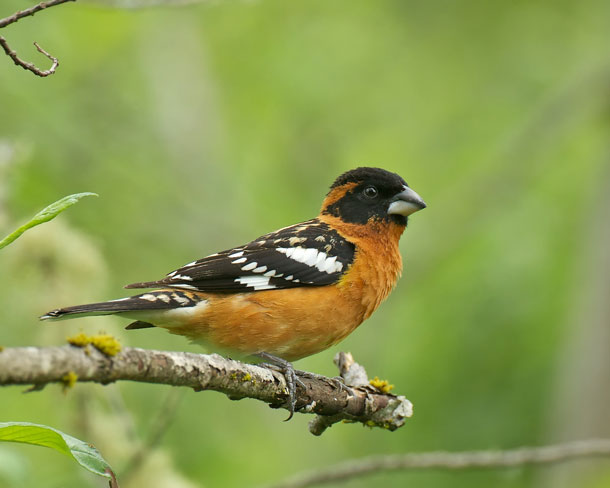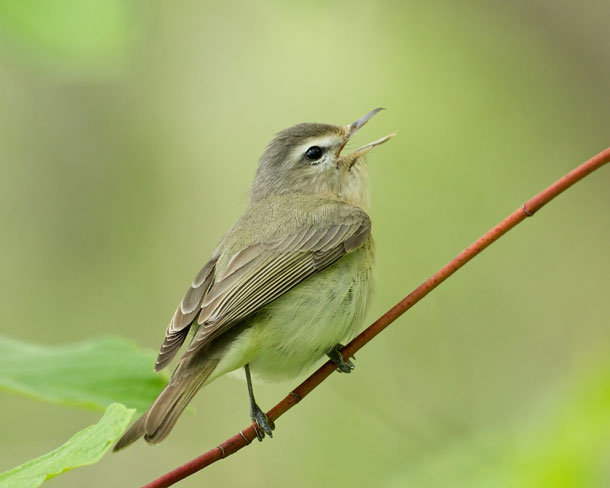BirdNote®: Where Are They Now?
Air Date: Week of January 25, 2019

Black-headed grosbeak (Photo: © Gregg Thompson)
During the Northern Hemisphere’s coldest days of the year, migratory birds that fly south for the winter warm their wings in the copious sunshine near the Equator. BirdNote’s Michael Stein tracks down these savvy sun-seekers.
Transcript
CURWOOD: Migratory birds that fly south for the winter are now warming their wings in the ample sunshine near the Equator. It’s hard not to envy them during the Northern Hemisphere’s coldest days of the year. So let’s live vicariously for a moment, and take a trip to Central and South America with BirdNote’s Michael Stein, as he follows these savvy sun-seekers.
STEIN: Where have the birds of summer gone? In July, you might have heard this dawn song – many birds singing at first light. [Full dawn chorus] Today, in winter, how utterly different the morning sounds.
[A few calls of Black-capped Chickadee.]
Where are the summer singers now?
[Song of the Swainson’s Thrush]
There’s the flutelike song of a Swainson’s Thrush, a bird now wintering in Central and South America, maybe as far south as Bolivia.
[Song of the Swainson’s Thrush]
Catch the rhythmic notes of a Warbling Vireo [song of Warbling Vireo] interspersed with lilting phrases of a Black-headed Grosbeak [song of Black-headed Grosbeak]

Warbling Vireo (Photo: © Gregg Thompson)
Warbling Vireos are now spread through much of Central America while Black-headed Grosbeaks have migrated to Mexico.
[Orange-crowned Warbler]
There’s the descending trill of an Orange-crowned Warbler, against a backdrop of robins. The warbler makes Mexico its winter home, as do some of the robins.
Now the raspy “fitz-bew” song of a Willow Flycatcher.
[song of Willow Flycatcher]
January finds it tucked away in Costa Rica or Panama. As winter turns to spring, these memorable singers will begin to fly north, where they will once again grace us with their rich dawn chorus.
I’m Michael Stein.
Written by Bob Sundstrom and Chris Peterson
Dawn Song and all birds except the featured Warbling Vireo and Black-headed Grosbeak were recorded by C. Peterson. Song of the Warbling Vireo and song of Black-headed Grosbeak provided by The Macaulay Library of Natural Sounds at the Cornell Lab of Ornithology, Ithaca, New York. Recorded by T.G. Sander.
Producer: John Kessler
Executive Producer: Chris Peterson
© 2005-2019 Tune In to Nature.org January 2019 Narrator: Michael Stein
Links
Living on Earth wants to hear from you!
Living on Earth
62 Calef Highway, Suite 212
Lee, NH 03861
Telephone: 617-287-4121
E-mail: comments@loe.org
Newsletter [Click here]
Donate to Living on Earth!
Living on Earth is an independent media program and relies entirely on contributions from listeners and institutions supporting public service. Please donate now to preserve an independent environmental voice.
NewsletterLiving on Earth offers a weekly delivery of the show's rundown to your mailbox. Sign up for our newsletter today!
 Sailors For The Sea: Be the change you want to sea.
Sailors For The Sea: Be the change you want to sea.
 The Grantham Foundation for the Protection of the Environment: Committed to protecting and improving the health of the global environment.
The Grantham Foundation for the Protection of the Environment: Committed to protecting and improving the health of the global environment.
 Contribute to Living on Earth and receive, as our gift to you, an archival print of one of Mark Seth Lender's extraordinary wildlife photographs. Follow the link to see Mark's current collection of photographs.
Contribute to Living on Earth and receive, as our gift to you, an archival print of one of Mark Seth Lender's extraordinary wildlife photographs. Follow the link to see Mark's current collection of photographs.
 Buy a signed copy of Mark Seth Lender's book Smeagull the Seagull & support Living on Earth
Buy a signed copy of Mark Seth Lender's book Smeagull the Seagull & support Living on Earth

